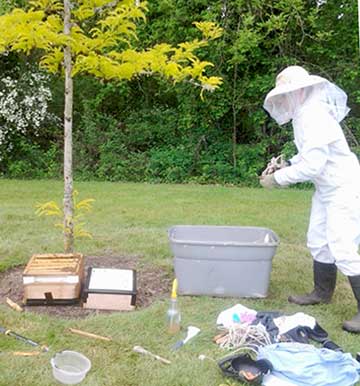 |
Previous Issues |
| Cedar Mill Community Website |
|
Search the Cedar Mill News: |
About The Cedar Mill News |
|
|||||||
| Volume 14, Issue 5 | May 2016 |
||||||
Tis the Season for Honeybee Swarming
|
||||
 |
When nectar is abundant, and as the population builds, subtle changes begin to occur in the hive, triggering the swarming impulse. The worker bee’s response to these signals is to reduce the queen’s food supply. She is being put on a diet so she’ll be ready for flight.
Meanwhile, the colony begins to construct queen cells (compartments in the honeycomb), encouraging the nurse bees to switch into a queen-feeding regimen. These cells are completely different from others found in the colony. Resembling peanuts in the shell, these are usually found along the bottom edges of the comb. One of the new residents will ultimately be the replacement for the old queen, who will soon leave the colony.
When the hive gets ready to swarm the existing queen lays eggs into the queen cups. New queens are raised and the hive may swarm as soon as the queen cells are capped and before the new virgin queens emerge from their queen cells. A laying queen is too heavy to fly long distances, therefore the workers will stop feeding her before the anticipated swarm date and the queen will stop laying eggs.
During the swarm preparation, scout bees will simply find a nearby location for the swarm to cluster. When a honeybee swarm (about half the colony) departs, usually early on a sunny day, they do not fly far at first. They may gather in a tree or on a branch, in a wall, or on the side of a building within a 50-60 foot distance from the hive. There, they cluster in a temporary bivouac around the queen and send 20-50 scout bees out to find suitable new nest locations.
This is the mass of insects the general public sees; all too often it is a source of alarm. The panic is totally unjustified as swarming bees are not the least bit interested in stinging. They have lost a home to defend and are in search of another and seem to understand this. This intermediate stop is not for permanent habitation and they will normally leave within a few hours to a suitable location. It is from this temporary location that the cluster will determine the final nest site based on the level of excitement of the dances of the scout bees. It is unusual if a swarm clusters for more than three days at an intermediate stop.
Sandra shares her story of a swarm that landed in a tree at her workplace:
 |
“The bees started showing up April 26 at my work. By April 27th, there was a pretty decent sized pile of bees on this poor tree in our courtyard. I am on the Green Team at work and the previous week we had organized an Earth Day Eco Fair for our employees. We had lots of different presenters that attended, including two bee organizations—Portland Urban Beekeepers and Tualatin Valley Beekeepers Assocociation. I had picked up a business card from one of them with a “swarm hotline” number: 503-444-8446. This number is good for all of Oregon (and maybe SW Washington). When you have a swarm, call the number, and they will alert beekeepers in the area to call you and come out as soon as possible. We called, and within an hour a beekeeper came out to collect them. She happened to be a member of Portland Urban Beekeepers. Bees are extremely important to us and these bee groups all work together under this hotline to rescue them. It is free-- they will gladly rescue the bees and take them to a new home.
“The beekeeper said the bees were very young. Most likely their hive was too small so they divided and took the queen to find a new home. They were also very hungry. She lured them into her bee box with liquid nectar.
“Once she got the queen in the box, the rest followed. She was there several hours and was very kind to answer the many questions from all the employees that came out to see what was going on. She left the box so the remaining bees would go in, and I believe she picked it up after dark, after they calmed down. She has an apiary at her home and they will stay with her.
“It was a win-win-win situation—bees were safely removed from a place they were not wanted, the beekeeper gained a hive, and the bees got a new home where they will be well taken care of.”
So if you encounter a swarm, contact our local beekeepers at Cedar Mill Roots Farm & Apiary, or contact one of the organizations listed below. They will capture swarms alive, ensuring proper relocation of our world’s most valuable pollinators (80% of the food we eat) the truly amazing Honey Bee.
Cedar Mill Roots Farm & Apiary: Jeff Garner (503) 867-4596, Jennifer Lytle (503) 939-9380. They sell local honey and pollen too!
Tualatin Valley Bee Keepers (503) 701-4180
https://portlandurbanbeekeepers.org/ 503-444-8446
![]()
Like us on Facebook for timely updates
Published monthly by Pioneer Marketing & Design
Publisher/Editor:Virginia Bruce
info@cedarmillnews.com
PO Box 91061
Portland, Oregon 97291
© 2016